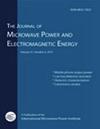Effects of microwave dryers on the properties of Jerusalem artichoke: physico-chemical, thermo-physical, energy consumption
IF 1.5
4区 工程技术
Q4 ENGINEERING, CHEMICAL
Journal of Microwave Power and Electromagnetic Energy
Pub Date : 2023-01-02
DOI:10.1080/08327823.2023.2166005
引用次数: 1
Abstract
Abstract Effects of pretreatments and drying methods on physico-chemical, thermo-physical, energy values were investigated. The longest drying duration was seen in control samples dried in hybrid microwave dryer at 350 W + 50 °C and the shortest in citric acid-treated samples dried in temperature-controlled microwave dryer. Citric acid-treated samples dried in temperature-controlled microwave dryer at 70 °C had the closest color values to fresh ones. Effective diffusion values of dried Jerusalem artichoke samples varied between 4.66 x 10−8 − 1.33 x 10−7 m2 s−1 and activation energy values varied between 14.53 − 41.74 kJ mol−1. Drying date was estimated with the Midilli-Küçük model. The highest specific heat, thermal conductivity and thermal diffusivity values were observed in control samples dried in temperature-controlled microwave oven at 60 °C and the highest density values were seen in citric acid-treated samples dried in hybrid microwave oven at 70 °C. The highest SMER value was observed in control samples dried in temperature-controlled microwave dryer at 60 °C. The lowest SEC value was seen in control samples dried in temperature-controlled microwave dryer at 60 °C. The lowest total energy consumption was encountered in citric acid-treated samples dried in temperature-controlled microwave dryer at 70 °C.微波干燥机对菊芋理化、热物理、能耗的影响
摘要研究了预处理和干燥方法对其理化、热物理和能量值的影响。在350 W + 50°C混合微波干燥器中干燥的对照样品干燥时间最长,柠檬酸处理的样品在温度控制的微波干燥器中干燥时间最短。柠檬酸处理后的样品在70°C的控温微波干燥机中干燥,其颜色值与新鲜样品最接近。干燥的菊芋样品的有效扩散值为4.66 × 10−8 ~ 1.33 × 10−7 m2 s−1,活化能值为14.53 ~ 41.74 kJ mol−1。用midli - k k模型估计干燥日期。在温度控制的微波炉中,60°C干燥的对照样品的比热、导热系数和热扩散系数最高,在混合微波炉中,70°C干燥的柠檬酸处理样品的密度值最高。在温度控制的微波干燥器中,在60°C下干燥的对照样品的SMER值最高。在60°C温度控制的微波干燥器中干燥的对照样品的SEC值最低。柠檬酸处理后的样品在70°C的温度控制微波干燥器中干燥时,总能耗最低。
本文章由计算机程序翻译,如有差异,请以英文原文为准。
求助全文
约1分钟内获得全文
求助全文
来源期刊

Journal of Microwave Power and Electromagnetic Energy
ENGINEERING, CHEMICAL-ENGINEERING, ELECTRICAL & ELECTRONIC
CiteScore
2.50
自引率
6.70%
发文量
21
期刊介绍:
The Journal of the Microwave Power Energy (JMPEE) is a quarterly publication of the International Microwave Power Institute (IMPI), aimed to be one of the primary sources of the most reliable information in the arts and sciences of microwave and RF technology. JMPEE provides space to engineers and researchers for presenting papers about non-communication applications of microwave and RF, mostly industrial, scientific, medical and instrumentation. Topics include, but are not limited to: applications in materials science and nanotechnology, characterization of biological tissues, food industry applications, green chemistry, health and therapeutic applications, microwave chemistry, microwave processing of materials, soil remediation, and waste processing.
 求助内容:
求助内容: 应助结果提醒方式:
应助结果提醒方式:


